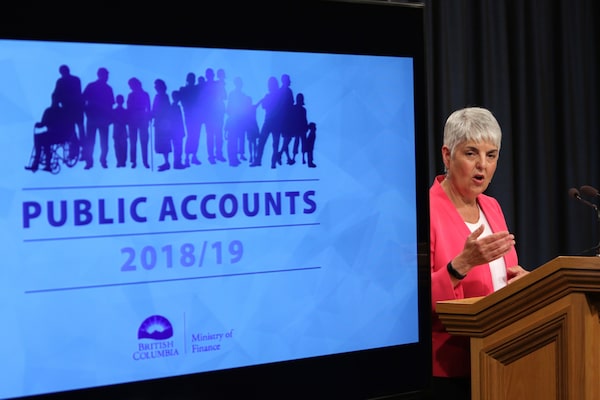
Finance Minister Carole James releases the provincial public accounts report during a press conference at the press gallery at B.C. Legislature in Victoria, B.C., on Thursday, July 18, 2019.CHAD HIPOLITO/The Canadian Press
One of the last acts of the BC NDP government of the 1990s was to try to restore its tattered fiscal credibility.
Then-premier Ujjal Dosanjh, who presided over the NDP’s final months in office, introduced the Balanced Budget Act. It required his government to achieve something it failed to do in nine consecutive years in office. “I am trying to chart a new course of fiscal responsibility,” Mr. Dosanjh explained.
It might have been a new course for the NDP government, which by then was firmly entrenched in voters’ minds as a tax-and-spend champion, but it wasn’t a new promise. In the 1991 provincial election, NDP campaign ads featured party leader Mike Harcourt dropping a coin into a piggy bank and promising, “we’ll do more with less. You can take that to the bank.” It was a theme he repeated on the campaign trail. If the money is not there, he said, we won’t spend it.
A decade later, Mr. Dosanjh couldn’t overcome voters’ skepticism that this time, the NDP could be trusted with the public purse. In the 2001 election, the New Democrats were left with just two seats in the legislature – not enough for official party status.
It took 16 years for the NDP to regain voters’ trust again – and with a minority government at that.
The long stretch on the opposition benches has left the New Democrats with a mighty aversion to deficit spending. That’s why Finance Minister Carole James is determined to bring in her third consecutive balanced budget on Feb. 18. “Our fiscal plan remains balanced,” she said, adding that the next budget “certainly” will be in the black.
Ms. James covets the province’s triple-A credit rating as much as any fiscal conservative, and she is happy to trumpet the private-sector forecasts that project that the province’s economic growth will be first among the provinces this year.
But she has to be careful. Ms. James faces all kinds of pressure to embrace deficit spending. To name just a few: The teachers’ union is rumbling about job action if cabinet can’t throw more money on the table for salaries. Then there is the still-unfulfilled election promises for a renters’ rebate and $10-a-day child-care plan.
Although British Columbia boasts one of the strongest economies in the country, Ms. James can’t count on growth for any big new spending initiatives.
In November, the Finance Minister delivered her most recent financial update, warning of volatility ahead for the economy. B.C. exports are declining, retail sales are slowing and the forest sector, in particular, is shrinking. The Crown corporations that usually provide dividends to government are underperforming. Even with a $1-billion cushion built into this year’s budget, the list of risks is daunting.
Ms. James uses these uncertainties as a defensive weapon when lobbyists come to the door looking for more spending.
Many of those spending demands come from allies of her government, who could perhaps be made happy without a huge financial impact. Why not run up a little deficit, a reporter asked her in November, when a small surplus is going to be difficult to achieve?
“From my perspective, that’s the job," she replied. “The job is to manage the economy well for the people of B.C. to make sure that you’re spending within your means, that you’re balancing the budget.”
Secretly, she might envy the ease with which the federal Liberal government was able to announce that next year’s deficit is heading toward $28-billion. But for Ms. James, the fear is that any hint of red ink will bring back vivid memories for voters of why they banished the NDP to opposition for so long.
Since her November briefing, another troubling peril for the provincial budget emerged.
In its most recent financial update, the Crown corporation BC Hydro revealed spending on construction of the Site C dam – the costliest public sector infrastructure project in the province’s history – is in trouble.
“Some areas of the project have experienced significant cost pressures and/or budget increases since the project budget was approved in February, 2018," the report warns, “and the revised budget did not contemplate certain unforeseen financial impacts.” The NDP approved the project and set the $10.7-billion budget after a thorough review.
The Finance Minister’s favourite word is prudence, but the real issue is reputation. Before B.C. voters return to the polls, the NDP under Premier John Horgan hopes to have laid the skeletons from the 1990s to rest. They’ll need to keep a firmer grip on their dam project to do that.
We have a weekly Western Canada newsletter written by our B.C. and Alberta bureau chiefs, providing a comprehensive package of the news you need to know about the region and its place in the issues facing Canada. Sign up today.
 Justine Hunter
Justine Hunter